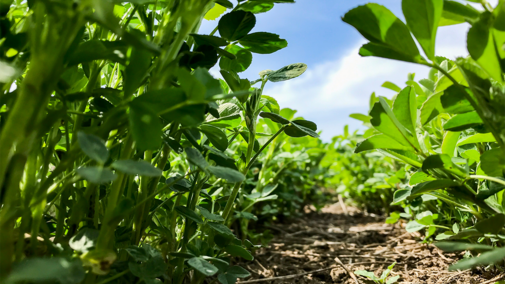Controlling Winter Annual Weeds
Now is the time to control winter annual weeds in alfalfa. Thinned alfalfa stands combined with open soil and adequate moisture can result in weed pressure. So, prior to alfalfa dormancy break and early green-up, assess winter annual weeds populations such as pennycress, downy brome, mustards, cheatgrass and shepherd’s purse. Left unchecked, these weeds can lower first cutting hay quality and palatability. Excessive weeds can also extend dry-down time and lengthen harvest time.
However, before applying any herbicide, scout fields to determine current and potential weed pressure. Verify that fields have enough weeds to justify herbicide spray applications and then determine the best management options.
If alfalfa fields are still dormant, Sharpen®, Metribuzin® and Gramoxone® herbicides can still be applied. Pre-emergent herbicides such as Warrant®, Chateau® and Prowl H2O® can be applied soon after green-up, but these chemicals will not control weeds which have already germinated. Aim® herbicide will control early growing broadleaf weeds, but it will not control grassy weeds. Poast® herbicide will control most growing weedy grasses but not downy brome. Pursuit® and Raptor® herbicides will control growing weeds during early alfalfa green-up, but control weeds best when air temperatures are warmer. Glyphosate (Roundup Weathermax®/Powermax®) will control growing weeds too but must be used with Roundup-tolerant varieties.
Other labeled products for new alfalfa include: Arrow®; Select Max®; Velpar®, Karmex®, Sinbar®; Pursuit®; and Raptor®. Our UNL Extension publication, EC 130, “Guide for Weed, Disease, and Insect Management in Nebraska” may provide additional options.
Winter annuals can quickly establish in hay fields, so early season weed control is important for quality hay production. Since timing is essential, control winter annuals before alfalfa breaks dormancy and before weeds render economic losses.
Evaluating Alfalfa Stands
Were you expecting more from last year’s alfalfa yields? Did your plants get enough time to winterize in the fall? Do you have concerns about stand winter kill? Evaluating your alfalfa stand in the spring is key to planning management and setting expectations for this year.
As stands begin greening up, alfalfa stand assessment can be completed using a hay square as a quick and easy way to look at the overall stand health. While we call it a hay square, square or circle shapes work equally well. A 17x17-inch square or 19-inch in diameter circle is the size needed.
Next, determine what to count. There are two options when evaluating your stand: 1) by the number of plants per square foot (typically recommended for new stands, planted last fall) and 2) by the number of stems for established stands. Stem count will more accurately predict yield compared to plant number. However, either method will provide information for making management decisions.
Pick four to five random areas in your field to sample. Then count the plants or stems that would be harvested, typically anything over six inches, to determine your count. Then divide those numbers by two to get stems or plants per square foot. For established stands, having four to five healthy plants per square foot or 55 stems per square foot would warrant a productive and healthy stand. Stem counts below 55 see a significant decrease in dry matter production.
For stands planted last fall, you will see more plants per square foot compared to stems. Remember, a good rule of thumb is, for every pound of seed planted, expect three to five plants. New plantings that contain fewer than 12 plants per square foot may need to be reseeded.
Grazing Winter Annuals
Grazing winter annuals such rye, winter wheat, or triticale commonly begins in April. All three of these forages can be very high in quality and reduce the need for expensive hay feeding and allow additional time for spring growth of our perennial summer pastures.
Because of cooler-than-normal temperatures this spring, growth may be a little behind. Begin grazing when the plants are about five to six inches tall and manage to keep the maximum height at eight to 10 inches. A good starting point is about 0.5 cow or one stocker calf per acre in early spring and increasing from there. Rotational grazing with higher stocking densities can assist with keeping the plant maturity more uniform and reduce selective grazing. Look ahead one or two pastures and move based on how the plants are recovering in those pastures. These forages grow fast and recover from grazing fast.
The most common mistake when spring grazing small cereals is letting the grass get ahead of the cattle. It is important to increase stocking density as the spring progresses to ensure the cattle can keep up with the rapid forage growth. This can be achieved by either adding more cattle or reducing the number of acres being grazed.
Like most cool-season grasses in early spring, small cereal forages are also high in potassium. This means there is a need to provide supplemental magnesium as potassium interferes with magnesium availability to the animal. A free choice mineral with a targeted four ounces per day intake should contain at least 10% magnesium to prevent grass tetany in lactating cows and 5% magnesium to increase gains in stocker calves.
For more information on this topic, check out the April BeefWatch newsletter and BeefWatch Podcast.

